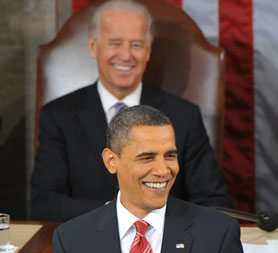Obama’s State of the Union test
As President Obama prepares for his second State of the Union address to Congress tonight, Felicity Spector looks at what’s at stake for the parties – and the United States.

The state of the union is – optimistic – or uncertain?
President Obama revealed the first details of his State of the Union address to his supporters, rather than the press, in a video e-mailed to members of Organising for America, the network born in the 2008 election campaign.
The main themes of tonight’s speech, to both Houses of Congress: more government spending, more growth and more jobs – while dealing with the burgeoning federal deficit in a “responsible way”. And, don’t forget – this is all coming at a time when the Administration’s had to accept an extension of the Bush-era tax cuts.
In the video to supporters, Obama declared that his “number one focus” was job creation: while his appeal, in these post-Tucson times, was for unity. “We’re up to it, as long as we come together as a people – Republicans, Democrats, Independents – as long as we focus on what binds us together as a people,” he said.
With one eye on his re-election campaign for 2012, Obama is doubtless pinning his hopes that America’s economic fortunes will turn around in time.
Some liberals have already questioned the decidedly-centrist message – wondering whether reaching too far across the aisle might just alienate Obama’s progressive allies – and yearning for some bolder vision. For others, though, the bi-partisanship is simply a political neccessity: as the leading senator Dick Durbin told Politico: “I think there will be more than ample opportunity for confrontation, but that’s not what the State of the Union will be about.
“It’s an effort for the President to engage the Republicans in a co-operative effort to do some things for the country, starting with turning the economy around. This is the right starting point.”
Ah yes, the economy. With one eye on his re-election campaign for 2012, Obama is doubtless pinning his hopes that America’s economic fortunes will turn around in time. And at first sight, at least, there are some signs of a potential recovery: retail sales, factory production and bank lending to small businesses are all rising, while some major firms are hiring new staff.
But economists are still highly cautious. The prospects for growth, they say, are constrained by high levels of debt and unemployment – while globally, food and fuel prices are on the rise. Harvard’s Professor Kenneth Rogoff told the New York Times that this was no ordinary recession, where after a few months things simply returned to normal.
“We’re still just crawling back to where we started”, he warned. “It’s going to take a few more years, really, before we’re back at whatever normal is.”
Spending clash
Tonight, though, President Obama will tell the American people the economy is finally on the mend – but only if there’s substantial investment, which he’s promised to offset with spending cuts. It’s not the easiest message to sell, with polls showing a substantial majority of people think he’s relying too much on government intervention to solve the country’s problems.
And it’s a message that could be an easy target for the Republicans, who’ve already pledged not to support any rise in Government spending. The man charged with responding to the State of the Union – the new Budget Committee chairman Paul Ryan – will demand an end to what he’ll call “Washington’s spending binge” – instead, arguing that cuts are the way to promote job creation in the private sector and tackle the public debt.
At just 40 years old, the little-known Wisconsin Congressman is poised to become one of his party’s most powerful figures – some are even calling him the “new face of the Republican party”.
With this in mind, the Democrats intend to focus on some of Ryan’s more controversial proposals – replacing the Medicare programme with vouchers and reigning back on Social Security spending, with at least some degree of privatisation – hoping that’ll prove even more unpopular with voters.
So, whatever the surface talk about bi-partisanship and working across the aisle, this a battle of fundamentally-opposing views of the economy, and the way to recovery: a preview of next month’s budget fight. The White House is sending out every single Cabinet member to push its message, while the GOP has warned “we’re going on offense”.
Read between the lines of tonight’s State of the Union, then. This is a public relations war – and one which neither side wants to lose.